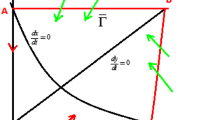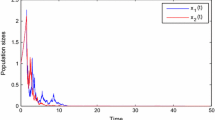Abstract
In this paper, two types impulsive delay stochastic budworm population models are proposed and investigated. Based on some standard assumptions, a series sufficient criteria about long time behavior of the solutions are given. For the unbounded positive impulse, we obtain a sufficient criteria that makes the solution weakly permanent, which is close to the necessary criterion. Then, we demonstrate the conditions that produce the solutions are stochastically permanent when positive impulse is bounded. Finally, numerical simulations of the model confirms our theoretical results. Our rsults improve and extend some previous results.



Similar content being viewed by others
References
Hallam, T.G., Ma, Z.E.: On density and extinction in continuous population models. J. Biol. Math. 25, 191–201 (1987)
Hallam, T.G., Clark, C.E., Lassider, R.R.: Effects of toxicants on populations: a qualitative approach I. Equilibrium environmental exposure. Ecol. Model. 18, 291–304 (1983)
Sasmal, S.K., Takeuchi, Y.: Evolutionary dynamics of single species model with Allee effects and aposematism. Nonlinear Anal. Real. 58, 103233 (2021)
Liu, Z.J., Guo, S.L., Tan, R.H., et al.: Modelling and analysis of a non-autonomous single-species model with impulsive and random perturbations. Appl. Math. Model. 40, 5510–5531 (2016)
Lv, H.B., Liu, Z.J., Li, Z.X., et al.: Two impulsive stochastic delay single-species models incorporating L\(\acute{\rm e}\)vy noise. J. Appl. Math. Comput. 58, 721–753 (2018)
Xu, Y., Gao, S.J., Chen, D.: Persistence and extinction of a nonautonomous switching single-species population model. Appl. Math. Lett. 103, 106187 (2020)
Liu, Q., Chen, Q.: Analysis of a general stochastic non-autonomous logistic model with delays and L\(\acute{\rm e}\)vy jumps. J. Math. Anal. Appl. 433, 95–120 (2016)
Gard, T.: Stability for multispecies population models in random environments. Nonlinear Anal. 10, 1411–1419 (1986)
Gakkhar, S., Singh, A.: Complex dynamics in a prey predator system with multiple delays. Commun. Nonlinear Sci. 17, 914–929 (2012)
Yang, J.T.: Permanence, extinction and periodic solution of a stochastic single-species model with L\(\acute{\rm e}\)vy noises. Discrete Cont. Dyn-B 26, 5641–5660 (2021)
Zhang, Y., Lv, J.L., Zhou, X.L.: Dynamics of stochastic single-species models. Math. Meth. Appl. Sci. 43, 8728–8735 (2020)
Liu, Q., Chen, Q.M.: Analysis of a stochastic delay predator–prey system with jumps in a polluted environment. Appl. Math. Comput. 242, 90–100 (2014)
Zhao, J.D., Zhang, T.H.: Permanence and extinction of a single species model in polluted environment. Int. J. Biomath. 13, 2500031 (2020)
Deng, Y., Liu, M.: Analysis of stochastic tumor-immune model with regime switching and impulsive perturbations. Appl. Math. Model. 78, 482–504 (2020)
Pan, T., Jiang, D.Q., Hayat, T., et al.: Extinction and periodic solutions for an impulsive SIR model with incidence rate stochastically perturbed. Physica A 505, 385–397 (2018)
Liu, C., Liu, M.: Stochastic dynamics in a nonautonomous prey-predator system with impulsive perturbations and L\(\acute{e}\)vy jumps. Commun. Nonlinear Sci. 78, 104851 (2019)
Cyr, J., Nguyen, P., Temam, R.: Stochastic one layer shallow water equation with L\(\acute{e}\)vy noise. Discrete Cont. Dyn B 24, 3765–3818 (2019)
Liu, M., Zhu, Y.: Stability of a budworm growth model with random perturbations. Appl Math. Lett. 79, 13–19 (2018)
Wang, Y.: Analysis of a budworm growth model with jump-diffusion. Physica A 531, 121763 (2019)
Ji, W., Hu, G.: Stability and explicit stationary density of a stochastic single-species model. Appl. Math. Comput. 390, 125593 (2021)
Belabbas, M., Ouahab, A., Souna, F.: Rich dynamics in a stochastic predator-prey model with protection zone for the prey and multiplicative noise applied on both species. Nonlinear Dyn. 106, 2761–2780 (2021)
Souna, F., Lakmeche, A.: Spatiotemporal patterns in a diffusive predator–prey system with Leslie–Gower term and social behavior for the prey. Math. Method. Appl. Sci 44, 13920–13944 (2021)
Lin, G.H., Ji, J.P., Wang, L., et al.: Multitype bistability and long transients in a delayed spruce budworm population model. J. Differ. Equ. 283, 263–289 (2021)
Tang, X.S.: Periodic solutions and spatial patterns induced by mixed delays in a diffusive spruce budworm model with Holling II predation function. Math Comput. Simul. 192, 420–429 (2022)
May, R.: Stability and Complexity in Model Ecosystems. Princeton University Press, Princeton (2001)
Duan, L., Huang, L.H.: Threshold dynamics of a vector-host epidemic model with spatial structure and nonlinear incidence rate. Proc. Am. Math. Soc. 149, 4789–4797 (2021)
Lv, H.B., Liu, Z.J., Chen, Y.P., et al.: Stochastic permanence of two impulsive stochastic delay single species systems incorporating predation term. J. Appl. Math. Comput. 56, 691–713 (2017)
Liu, Z.J., Guo, S.L., Tan, R.H., et al.: Modeling and analysis of a non-autonomous single-species model with impulsive and random perturbations. Appl. Math. Model. 40, 5510–5531 (2016)
Lipster, R.: A strong law of large numbers for local martingale. Stochastics 3, 217–228 (1980)
Hussain, G., Khan, A., Zahri, M., et al.: Stochastic permanence of an epidemic model with a saturated incidence rate. Chaos Soliton. Fract. 139, 110005 (2020)
Lan, G.J., Wei, C.J., Zhang, S.W.: Long time behaviors of single-species population models with psychological effect and impulsive toxicant in polluted environments. Physica A 521, 828–842 (2019)
Author information
Authors and Affiliations
Corresponding author
Additional information
Publisher's Note
Springer Nature remains neutral with regard to jurisdictional claims in published maps and institutional affiliations.
This work is supported by the NNSF of China (12071105) and the Key Projects of Science Research in University of Anhui Province (KJ2021A1049)
Rights and permissions
About this article
Cite this article
Kuang, D., Liu, Y. & Li, J. Analysis of impulsive stochastic delay budworm population model with L\(\acute{\mathrm {e}}\)vy jumps. J. Appl. Math. Comput. 69, 785–810 (2023). https://doi.org/10.1007/s12190-022-01768-1
Received:
Revised:
Accepted:
Published:
Issue Date:
DOI: https://doi.org/10.1007/s12190-022-01768-1




